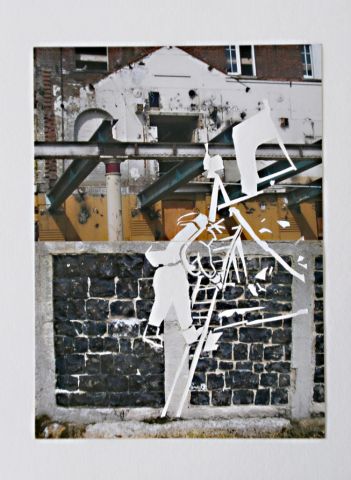Thanks Jean for your comment, I have ordered a copy of the book already, sounds interesting. Seen an interesting reference on Claire Manning’s blog too, so post MA progress is about more research, but that is good I am thinking.
As for progress with the newly found photographs of photoshoots, well, it kinda started from where I left off, Photoshoots 1, in that the poses and compositional aspects were identified with obvious focus.
But then the wider studio shots with the red-screen as part of a room seemed to create a different response, Photoshoots 2. The screen is intended to function as a neutral, to separate the figures from the context, but here it seems to in fact emphasise that process of situating the focus. Not sure that makes sense as I am trying to find the words, but the part normally cut out (red-screen) remains here and the subject is absent, and that seems interesting.
Photoshoots 3, are the best pieces so far and the more ambiguous the better I think, as it forces the looking, it forces anticipation. Not sure where next, but representation is not familiar here but it is implied, and seems different, there is a certain uncertainty that is ‘un-ordinary’ and yet there is nothing to sustain the idea that it is exceptional to the ordinary. Contradictory yes, intriguing perhaps, but it does follow my interests in the viewer’s role in signification. Hmm.
The Snapshots series continues, but it started with a shift from cutting and peeling 4 x 6 inch photographs to leave only singular objects that could be juxtaposed with other such cut-outs to create ‘plausable’ images collaged together.
Snapshots focuses on the compositional arrangements inherent in such images. There is a certain familiarity and universality to the images that speaks of the ritualistic marking of time, the restating of family ties, rites of passage and also the incidental capture of off-hand moments of the everyday.
Researching the photographic image Roland Barthes identifies 4 messages at work in photographs. So as I found myself separating the symbolic image from the denoted, as I removed the indexical trace from the photograph as I cut and peeled the surface away, the focus on cultural conventions comes to the fore. Snapshot 26 signifies objects that are part of celebration while the posed figures grouped together enforces that universal ritual. Snapshot 17 puts emphasis on the mundane as an off-hand moment is captured in a familiar un-posed composition. Snapshot 13 oddly enough perhaps reveals the incidental while all present in the group pose for the ritualistic recording of family, the foot insists on having some attention.
So the project is a sincere exploration yet also playful in approach. I have found some posed photographs by others of fashion shoots and the like, which I am currently working on, which set different conditions as a starting point. So it maybe that some consistent differences will arise from that. We shall see.






